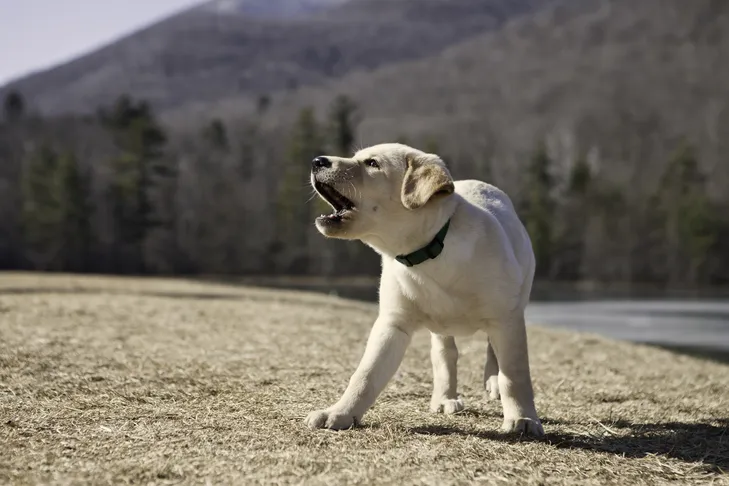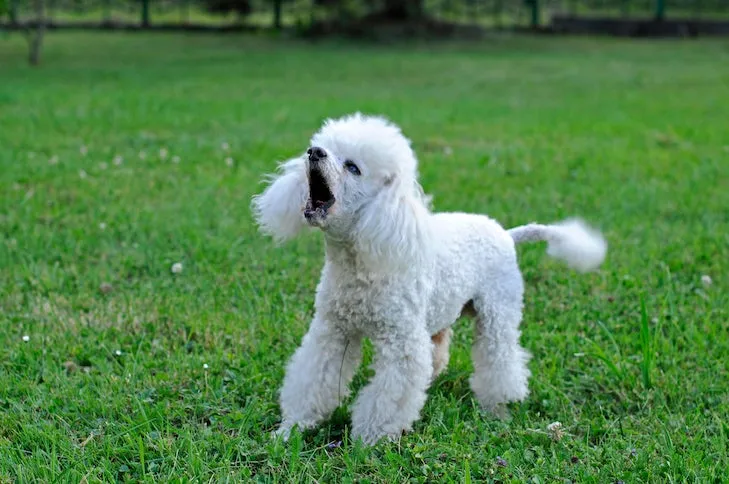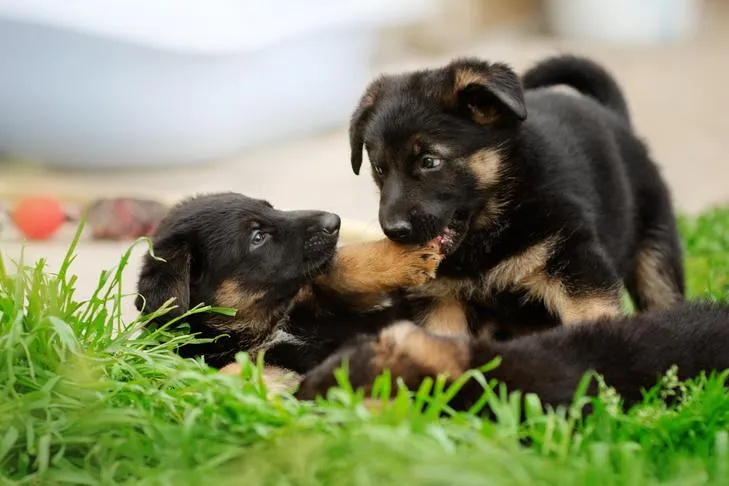Witnessing a dog barking and lunging at the end of their leash is an all-too-common sight that can be unsettling for both owners and passersby. This intense display of behavior often leaves us wondering about the underlying motivations: Is the dog frustrated, fearful, or potentially dangerous? While it’s tempting to immediately label such outbursts as aggression, the reality is more complex. Dogs exhibiting reactions that are disproportionate to a situation, like barking hysterically at a dog through a fence, are demonstrating reactivity. Though reactivity can escalate to aggression, understanding the distinction is crucial for effective intervention and Training Out Aggression In Dogs. This article will delve into these behaviors, their causes, and how to approach them with effective training strategies.
Understanding Dog Reactivity: More Than Just “Bad Behavior”
Dogs that respond to routine, everyday occurrences with abnormal and excessive levels of arousal are typically termed reactive. For instance, while most dogs might merely glance at a stranger on a walk or show a friendly interest, a reactive dog might react with intense barking, lunging, cowering, or pulling frantically on the leash. These are behaviors that are out of proportion to the actual situation. Reactive dogs are often overwhelmed by the emotions triggered by a particular stimulus, making it incredibly difficult for them to calm down or respond to their owner’s commands. For anyone who has tried to walk a reactive dog, the challenge is clear once they’ve been set off – good manners and a relaxed leash walk quickly disappear, and the owner’s primary goal becomes managing the dog away from the trigger.
What Causes Reactivity?
While fear is a common driver for reactive dogs, other underlying emotions such as frustration or over-excitement can also play a significant role. The key characteristic of a reactive dog is their faster and more intense response compared to a non-reactive counterpart. Rachel Lane, M.Sc., CBCC-KA, CPDT-KA, owner of Leash & Learn dog training, highlights that reactivity isn’t confined to a single environment; it can manifest on-leash, off-leash, indoors, or outdoors.
Dogs that become frustrated when their eagerness to greet another dog or a person is hindered by a leash, fence, or other barrier often struggle with emotional self-control. Conversely, anxious dogs frequently exhibit reactivity due to insufficient socialization during their puppyhood. What would be minor incidents for other dogs can become overwhelmingly stressful for them. Additionally, a prior negative experience, such as an attack by another dog, can instill fear that contributes to reactivity later in life. Lane emphasizes that “It is important to keep in mind that the threat a dog is reacting to may not be scary for the person on the other end of the leash. The threat simply has to be scary for the dog for them to display reactive behavior.”
 Yellow Labrador retriever puppy barking intensely outdoors, illustrating reactive behavior.
Yellow Labrador retriever puppy barking intensely outdoors, illustrating reactive behavior.
Demystifying Dog Aggression: When Instinct Takes Over
Aggression in dogs is defined as any threatening or harmful behavior aimed at preventing conflict escalation, increasing distance from a perceived threat, or causing harm to a target. While aggression can unfortunately lead to biting or, in severe cases, euthanasia, it is a normal canine behavior that can be adaptive and appropriate depending on the context. For example, if your dog were to confront an intruder, their aggressive behavior would likely be viewed as courageous and loyal.
Rachel Lane further explains that “Aggression is a part of a dog’s natural and normal behavioral repertoire and has multiple causes. People often consider aggression socially unacceptable, but all dogs are/can be aggressive. Like any behavior trait, aggression is a complex interplay of genetic and environmental factors.” Understanding aggression is a vital step toward training out aggression in dogs safely and effectively.
What Causes Dog Aggression?
Fear is the most common cause of dog aggression, leading many cases to involve dogs attempting to create distance between themselves and a perceived threat. However, numerous other factors can trigger aggressive behavior, including:
- Maternal aggression: A mother dog’s instinct to be overly protective of her puppies.
- Resource guarding: When a dog defends items they perceive as valuable, such as food, toys, or sleeping spots. Understanding how to train out resource guarding is key in these scenarios.
- Territorial aggression: The dog protects what they consider their domain, like their home, yard, or vehicle.
- Protective aggression: The dog guards a human companion, such as their owner.
- Pain aggression: A dog experiencing discomfort may react aggressively to any touch or movement that could intensify their pain.
Aggression can also be influenced by a dog’s age, breed, size, and home environment. A study published in Scientific Reports on aggressive behavior in thousands of Finnish dogs found that older dogs, male dogs, smaller dogs, and those lacking the company of other dogs showed an increased likelihood of aggression toward people. This was also true for dogs with novice owners and those with fearful personalities. Certain breeds, such as Collies (rough), Toy Poodles, and Miniature Schnauzers, exhibited higher odds of aggressive behavior compared to breeds like Labrador Retrievers, Golden Retrievers, and Lapponian Herders.
 Poodle standing in the grass, displaying an aggressive stance with barking.
Poodle standing in the grass, displaying an aggressive stance with barking.
The Link Between Reactivity and Aggression: A Slippery Slope
Given that dog reactivity involves heightened emotional arousal and aggression entails conflict or harm, is there a direct relationship between the two? Absolutely. Reactive dogs are at a high risk of developing aggressive behaviors depending on the situation and their past experiences. When a dog is in a highly emotional state, the “thinking” parts of their brain are often shut down, making them more likely to act instinctively with fight, flight, or freeze responses rather than considering their actions. This makes the process of training dogs out of aggression even more challenging.
Furthermore, reactive dogs, particularly those driven by fear, can learn that aggression yields desired results. For example, if a dog growls at a stranger and the growl is ignored, the dog may escalate to snapping or biting, effectively driving the stranger away. Lane notes that the primary goal of reactive behavior is often to increase the distance between the dog and the perceived threat. She warns, “It is important to note that while a dog may currently be performing reactive behaviors and has never injured another person or dog, these behaviors can morph into defensive aggression. This change can happen over a period of time, such as after the dog’s many attempts to create distance between themselves and a stimulus have repeatedly failed. Or a dog’s behavior may escalate during one single interaction with another individual.” This highlights the importance of early and consistent intervention.
 Two German Shepherd puppies playfully wrestling in green grass, representing natural dog interaction.
Two German Shepherd puppies playfully wrestling in green grass, representing natural dog interaction.
Effective Strategies for Training Out Aggression in Dogs
Reactivity is profoundly distressing for dogs, and its potential to escalate into aggression underscores the importance of prevention and early intervention. Socializing your dog, providing positive exposure to diverse situations and people, and teaching emotional self-control are vital preventative measures. However, if your dog has already developed reactivity or aggressive tendencies, Lane cautions that “There are no quick fixes. An owner’s participation, consistency, and follow-through all play a critical role in a successful behavior modification plan.” This is paramount when attempting to how to train a dog out of aggression.
Lane’s first recommendation for any behavioral change is to rule out potential medical causes with your veterinarian, as health issues can often underlie sudden aggression or reactivity. Once health concerns are addressed, seeking the guidance of a qualified professional, such as a certified behavior consultant or veterinary behaviorist, is crucial. She then advises a structured, multi-step program:
- Practice Management: The initial step involves proactively avoiding situations that emotionally arouse your dog. This might mean walking during quieter times of the day, steering clear of busy parks, or otherwise preventing your dog from encountering their triggers. The goal is to minimize opportunities for your dog to practice undesirable behaviors.
- Positive-Reinforcement Training Program: Implement behavior modification protocols such as desensitization and counterconditioning. Desensitization gradually exposes your dog to triggers at a low intensity, while counterconditioning aims to change your dog’s emotional response to those triggers from negative to positive. Teaching incompatible behaviors, like having your dog look at you instead of staring intently at a distant dog, can also be highly effective. This also helps with issues like how do i stop my dog jumping up by redirecting their focus.
- Learn to Read Dog Body Language: Developing the ability to recognize subtle signs that indicate your dog’s emotions are shifting—such as lip-licking, yawning, or pinning back their ears—allows you to intervene proactively before your dog escalates to reactive or aggressive behaviors. Early intervention can prevent a full-blown outburst and reinforce positive associations.
An optional, fourth step may involve medication. In some cases, medication can help calm your dog, making them more receptive to learning new behavior patterns and more comfortable during the training process. By diligently following this comprehensive program, your dog can gradually form new emotional associations with their triggers, leading to a significant reduction in reactivity and an improved ability to manage their emotions.
Conclusion
Understanding the nuanced difference between dog reactivity and aggression is the cornerstone of effectively training out aggression in dogs. While reactivity is an excessive emotional response, it can be a precursor to aggression, which involves threatening or harmful behaviors. Addressing these issues requires patience, consistency, and often, professional guidance from a veterinarian or certified behavior consultant. By implementing strategies like careful management of triggers, positive-reinforcement training, and learning to interpret your dog’s body language, you can help your canine companion develop better emotional control and build positive associations. There are no quick fixes, but with dedication, you can foster a safer, happier environment for your dog and everyone around them. Consistency in applying these principles is key to success in modifying these challenging behaviors.
